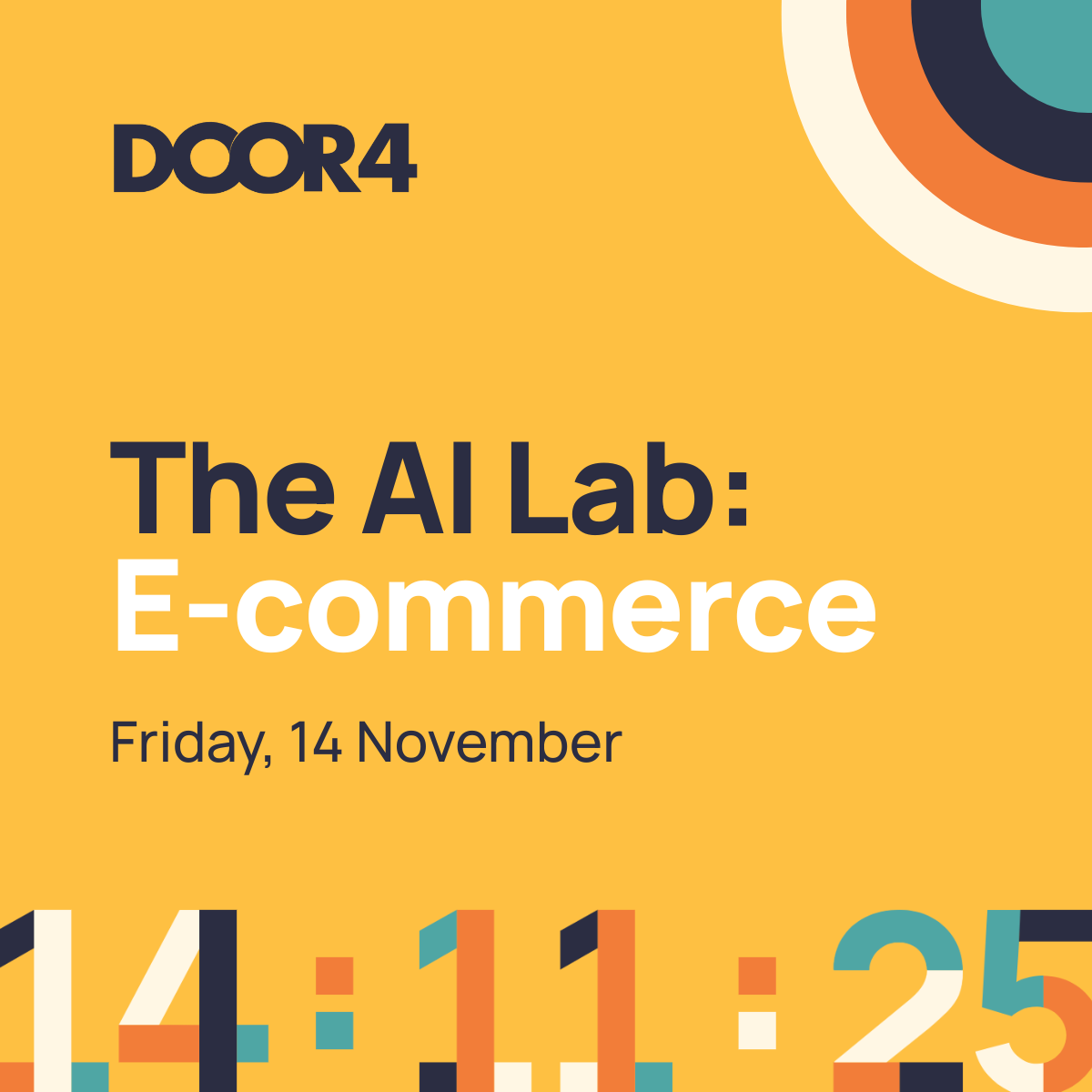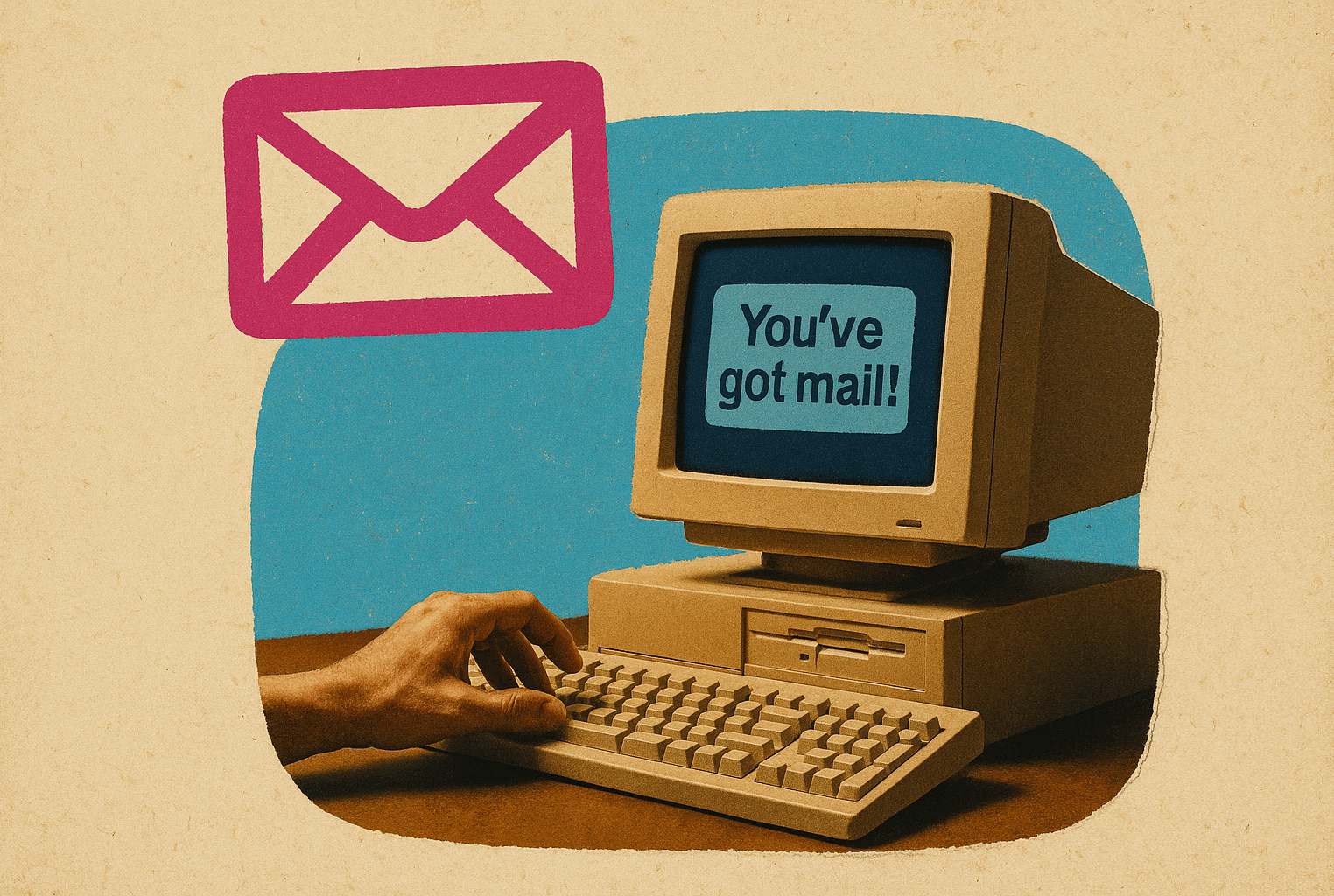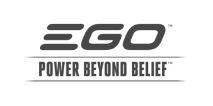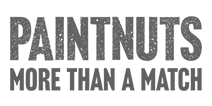Knock, knock… You’ve got mail (for the last time)
In the mid-90s, few sounds were as instantly recognisable as the screech and ping of a dial-up connection. That audible handshake was the gateway to a strange new world called “the internet”—and it felt both futuristic and fragile all at once. Now, with the announcement of AOL dial-up services finally winding down, we gather at Door4 to reminisce.
It’s easy to forget how new and even magical the online realm once seemed. Back then, you not only needed patience, you needed a certain pioneering spirit just to endure the connection process without shouting at the family phone line. Today, the internet is entrenched in our daily routines, from our commutes to our coffee breaks. Yet the memory of dial-up reminds us that once upon a time, simply being online was more novel than any digital marketing trick.
Slow Speeds, Big Dreams: The Early AOL Era
It’s surreal to consider how much the internet has morphed into something swift and perpetually accessible when, originally, it was so painstakingly slow. Early adopters recall the day they first heard a robotic dial tone, crossing their fingers that their connection wouldn’t drop. Forget streaming in ultra HD—just loading a single web page sometimes took half a minute or more. If someone picked up the phone in the house, kiss that session goodbye!
During the 90s, dial-up dominated. In fact, The Guardian once reported that at the turn of the millennium, AOL had tens of millions of subscribers dialling in daily. This widely distributed service was as integral to the internet for many as any modern broadband is today. Yet, for those who used it, AOL was not just a home page— it was chat rooms, buddy lists, and an encyclopedia of digital “firsts.”
Pamela Seal, Door4, recalled,
“The never forgotten dial-in tone, always wondering if it would connect this time. The distinctive noise would often give away when it was about to fail. We dreaded the ‘blue bar of doom’ at the top of the screen while pages took an eternity to load!”
Flaky? Certainly. But also thrilling. AOL gave novices an all-in-one environment that was both a familiarity blanket and a stepping stone into the wider web.
Our Very First Time: Discovering the Web with Door4
We asked the Door4 team to share their recollections of stepping onto the World Wide Web and how those experiences still reverberate in our modern marketing practice.
Leon Calverley, Founder at Door4 said,
“I remember, very clearly, my first experience in October 1994 at Salford University. We’d read about this ‘www thing’ and Mosaic, a very early web browser. One day, the lab tech showed me Mosaic—now available throughout the department—and I remember checking Radio One Essential Mix playlists. That was the turning point for my career!”
Leon’s recollection of Mosaic—a pioneering web browser—harks back to a time when simply finding a website felt revolutionary. While dial-up might have been slow, the thrill of exploring these new digital “territories” was immeasurable.
Steve Dixon, Developer, Door4, explained,
“My first time using the internet was down at Nelson Library in 1996. You paid £5 for an hour. I jumped on AltaVista or HotBot. Yahoo existed, but it was just a directory—not really a ‘search engine.’ It seemed pretty amazing at the time to see an unlimited amount of stuff on the web.”
An hour might not sound like much by today’s standards—particularly when we wander online for hours without blinking—but it felt huge in a universe where data metre-wheels were constantly ticking.
Whirring Modems and Busy Phone Lines
Patience proved essential in the dial-up era. Downloading a single file took minutes, maybe even hours. Everyone in the household had to compromise: you could either browse or talk on the phone—never both at the same time. Some of our colleagues can still hum the shrill dial-up tune in their sleep.
Annabel Pearson, Marketing Lead at Door4, commented,
“Yes, I remember the sound, but the net got better quickly around the time we got our family PC. There was much less to do online back then, but I still spent hours on MySpace pages, forums, and playing The Sims.”
That sense of “less to do” might ring odd to younger generations used to near-limitless content. But in the mid-to-late 90s, content was scarce and loading anything took patience. It meant you chose your online adventures carefully. Even so, it was easy to fill an entire evening just messing around on a new message board, or tweaking your MySpace profile until the dial-up croaked.
Tom Morton, Head of Activation at Door4, said,
“I was happily playing Cartoon Network games in the early 90s, only to be told off by my mum because she wanted to make a phone call. The email address I still use is my original AOL one, and I have 9999+ spam emails going back to MySpace days!”
Tom’s memory captures a particular frustration. The landline was a lifeline not only for your internet connection but for everyday communication (and parental scolding). It also shows how that era left its mark, sometimes literally.
Online Portals, Chatrooms, and the Moment of Discovery
If dial-up was the access point, AOL frequently acted as the gateway drug: offering chat rooms, curated content, and the allure of connecting with strangers from across the world. Many team members remember stumbling into these communities, discovering simultaneously the wonders and perils of unfiltered conversation. Some took it further by volunteering as moderators—keepers of early netiquette.
Pamela Seal, Door4 told us,
“In 1997, I was one of the first 15 UK online Guides in AOL Chat rooms. We were trained by Americans on dealing with trolls, child safety, and everything else. We dreaded the 2am to 5am shift, finger poised over the ‘chuck them out’ key whenever people violated the rules. It taught me Windows, how to type quickly, and a lot about online culture. Some of it was definitely wild.”
It’s easy to forget that the internet once felt like a smaller, more lawless place. The combination of anonymity and novelty produced surprising interactions, some uplifting, some troubling. For those who moderated chat rooms, it wasn’t always fun, but you gained new skills that would shape the next decades.
Typo Mishaps and Hardcore Surprises
Dive back into the late 90s or early 2000s, and you’ll remember that one keystroke in the address bar could send you to unexpected places. Younger users didn’t always know what they might stumble on. With so much less parental control software and more naive searching, it could easily go wrong. Indeed, sometimes curiosity met with shocking results.
Carly Tallentire, Door4, recalled,
“The first website I ever visited was a dress-up doll site called Paper Doll Heaven. I typed the wrong thing, and a load of porn popped up. I was about six—I had no idea what I’d done, but it scarred me!”
This anecdote might be comedic in hindsight—though definitely terrifying for a child in the moment. Yet it captures the anything-goes nature of searches in the early days. AOL might have tried to corral users with its own curated content, but the web was (and still is) filled with unexpected corners.
When Music and Movies Took Hours to Arrive
Once people got a taste for dial-up, they discovered ways to push it to the limit. Downloading music was something of a clandestine hobby. Were you on LimeWire or Napster in the early 2000s? If so, it might have felt like digital alchemy to watch those green progress bars crawl across the screen until you finally had an MP3 (probably mislabeled) at 128 kbps. A single track could take half an hour, but it was exhilarating to build your library (for free).
Darren Taylor, UX Lead at Door4, reminisced,
“When LimeWire came along around 2000, my music collection grew exponentially. I still have some of those ‘ripped’ CDs in my loft. Back then, connecting was a distraction more than a productivity tool, but that sense of opportunity was huge. I became the guy who set up neighbours online, and my phone was always ringing for free IT support.”
In these times, people often discovered software (for good or ill) by word of mouth. It was a chain reaction of receiving tips or copying CDs to pass around. Broadband was still a pipe dream; dial-up reigned. But even with its snail pace, it opened new horizons for music fans, budding entrepreneurs, and soon-to-be marketers alike.
The Unintentional Lessons of Early Internet
These amusements and frustrations laid the groundwork for many in the Door4 team to become digital professionals. Some discovered a knack for coding thanks to customising MySpace templates or modifying game forums. Others learned the power of community building by observing how people rallied around chat rooms, bulletin boards, and special interest hubs.
Romesa Kamran, Door4, said,
“It was all about people, not just pixels. Early web was a wild west, no rulebooks. If you wanted a custom MySpace profile, you learned a bit of HTML. That environment taught me to be curious, to experiment, and to value authenticity. Brands that broke through were the ones that talked with us, not at us.”
Therein lies the golden thread from dial-up to digital marketing: early experiences taught us that real community engagement is not about speaking the loudest, but speaking meaningfully. Online platforms were never just about technology. They were about forging a tribe, building relationships, and evolving strategies by listening to real people’s responses.
Annabel Pearson added,
“I used the internet as a creative outlet—writing, blogging, sharing art. It’s all connected to my career now. The early sites were a place to express yourself, in ways that definitely shape how we design messaging at Door4 today.”
Nostalgia as a Powerhouse for Modern Marketing
In marketing, nostalgia can be a big pull. The moment you hear a dial-up tone or see a pixelated GIF, it teleports you back to that simpler time, or at least a time that feels simpler in hindsight. People smile, remembering the thrill and frustration. Harnessing that emotional recall can be powerful for brands aiming to foster genuine connection.
Our daily work at Door4 is all about harnessing digital for growth and engagement, but the best campaigns are the ones that elicit strong emotions. Dial-up era references, like squealing modems and MySpace profiles, remind audiences of the first times they discovered the internet, forging a sense of shared history that resonates on a human level.
Darren Taylor pointed out,
“Everything was much slower, but that also meant more space for reflection. We don’t have that now—nobody waits for anything. When we weave nostalgia into marketing, it reminds people of patience, wonder, and everything else we once found so remarkable.”
A quick rummage around social media hashtags reveals the popularity of throwback-themed campaigns. The notion of being “offline” is increasingly appealing to those weary of the endless scroll. In some ways, referencing the era of dial-up is more relevant now than ever, because it celebrates an era when you had to pause, adapt, and explore intentionally.
Flash Games, Forum Friends, and Fumbling Our Way Forward
While it’s tempting to remember dial-up as all frustration, these recollections remind us it was also playful. Games, forums, newsgroups, and even blog posts gave us a sense that something new was unfolding nearly daily. People typed in a new search engine name, discovered a new web ring, acquired a strange new computer skill.
Liam Driver, Door4, said,
“When I was about 5, using the internet meant playing Flash games on the family computer. It felt like a big treat. I was excited because going on the computer was still something special. Now, it’s just part of daily life, but back then it was novel and surprising at every turn.”
That novelty factor was a big part of the stay-up-all-night impetus. Websites were places to experiment, connect, or laugh at bizarre memes long before memes became mainstream. It’s hard to overstate how quickly the culture evolved. In one moment, you’re dealing with a 14.4 kbps modem just struggling to load a single webpage. Fast forward a few short years, and broadband transforms the entire game.
The Dial-up to Door4 Connection
On the surface, dial-up tales might be just amusing snapshots of early internet awkwardness. But for the folks at Door4, they’re also origin stories. Curiosity about “this new digital world” led many to discover a passion for marketing, design, coding, or tech strategy. That intangible sense that an online presence could be shaped, curated, and harnessed for something bigger forms the backbone of modern digital marketing. The foundation was set decades ago when we waited in line at libraries to pay by the hour or raced to the computer lab to load Mosaic for the first time.
And look at us now—crafting full-scale campaigns, building entire brand ecosystems, and enabling businesses to grow in ways unimaginable back when a single photograph might take a minute to load. But the shared memory of connecting to something beyond your local area code is still humbling and a little bit awe-inspiring, even in an era of 5G.
Leon Calverley said it best:
“Using the internet in those days felt magical. We had Microsoft Encarta on CD-ROM, which held 650 mb of content that felt enormous in 1994. Now we can consume that much data without a second thought. It’s easy to forget how quickly things changed.”
Old Connections, New Perspectives
Though dial-up’s prime is a distant memory, it shaped how we all approach technology. Dial-up forced you to ask: “Is this worth my time?” or “Do I really need to click that link now?” That consideration can be a valuable mindset in modern marketing, where we must be mindful in crafting user journeys. Speed and convenience are nice, but they can also breed sloppiness. Taking a moment to reflect encourages purposeful design and content curation.
Furthermore, that sense of exploration from the early days can still help us invent new approaches. Instead of passively letting technology define what is possible, we can ask how best to connect with people, just as we did in the IRC or AOL chat rooms. That might mean building digital communities, emphasising authenticity, or testing new forms of online engagement with the same curiosity that once propelled us to dial in at 2 a.m.
Romesa Kamran put it succinctly:
“Real connection will always be more powerful than just broadcasting a message. That sense of community from the early days has huge relevance now, particularly as people crave more authentic interactions.”
No more waiting for the world to load
It’s the end of an era. AOL, once the gatekeeper to the wide digital world, no longer offers the dial-up services that launched so many of our online lives. While we might not miss the screech or the constant interruptions from phone calls, we can’t deny the significance of that moment. For many, AOL and other dial-up services were the wellspring of digital possibility, like an on-ramp to what is now an endlessly humming information superhighway.
As we move forward, it helps to have these shared memories reminding us that the journey from dial-up to gigabit broadband was never just about speed. It was about how we adapt to new frontiers, how we build relationships with people half a world away, and how we discover the hidden corners of creativity that a simple phone line can unleash. At Door4, we celebrate that heritage. And we invite readers: What were your earliest online recollections? If you hear that disjointed modem tone in your imagination, does it make you laugh, wince, or both?
Contributors
- Leon Calverley, Founder, Door4
- Annabel Pearson, Marketing Lead, Door4
- Tom Morton, Head of Activation, Door4
- Darren Taylor, UX Lead, Door4
- Romesa Kamran, Account Executive, Door4
- Liam Driver, Paid Media Specialist, Door4
- Carly Tallentire, Account Manager, Door4
- Steve Dixon, PHP Web Developer, Door4
- Pamela Seal, HR Manager, Door4
Thank you to our contributors for sharing these cherished memories and insights.
Bye-bye AOL dial-up. Brrrrrchh.










